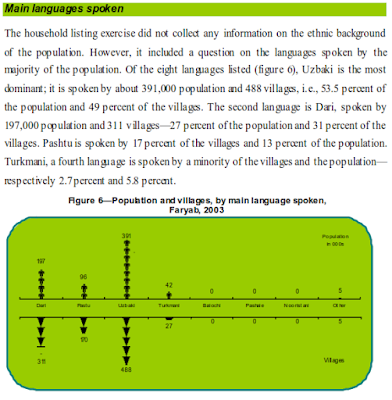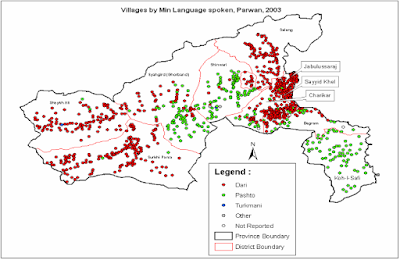Herat, since its fall to Afghans has been gradually populated by Pashtuns, as it was considered one of the gateways to Iran. The Pashtun migration to Herat province became more pronounced at the time of Amir Abdul Rehman of Afghanistan (1880-1901), which resulted in Pashtunization of Herat Province.
Historically, Herat city is considered to be Tajik/Farsiwan enclave in a Pashtun province. South, West and North East of the province is dominated by Pashtuns, while East, North East and Herat city is dominated by Farsi speaker of variety of ethnic backgrounds. The Pashtun population that envelops the centers from south, west and north east also spills over into Iranian side of the border, while the Pashtun people from the south of the province reach all the way to Herat city before the population changes its character to Farsiwan/Tajik.
In recent years there has been substantial settlement of Hazaras and Aimaks into Herat City, while East of the province is congruous with central Afghanistan's region dominated by Aimaks therefore East and North east of the province, albeit low in population density, is dominated by Aimaks. Most Tajiks in Herat Province live in and around Herat city and the districts surrounding it.
Below is the DATA from UNHCR Report in 1990:
Adrakshan: Mainly
Nurzai Pashtun, with some Tajik and Aimaqs.
Chisti Sharif: Mix
of Pashtun, Tajik and Others.
Enjil: Tajik,
Pashtun and Syeds.
Ghorian: Pashtun
(Durrani30%), Tajik (20%), Aimak, Hazara, other pashtuns.
Guzara: Pashtun
and Tajiks.
Herat: Mixed.
Karukh: Tamorai,
Jamshidai, Tajik and Zoori. The largest is the Tamorai.
Kushk: Jamshidi make up 50 percent of the population,
Taimuri 20 percent and Zari 15 percent.other groups are Firuz Kohi,
Taheri, Mish Nast, Balochi, Turkaman and Pashtuns. The Pashtun tribes include the
Kakar, Alizai, Ishaqzai and Nurzai.
Kohsan: The different ethnic and tribal
groups include Pushtuns, Baluch, Jamshidis, Taheris, Taimori
(Khamadis) and Mish Mast. The Baluch tribes consisting of the Rakhshani, Barahoi,
Gala Bacha (sub-tribe), Rigi and Dahmarde, make up about 25 percent of the population.
Within the Pushtuns, the Alizais form about 18 percent and the remainder consists
of Baritchs, Achakzais, Populzais, Nurzais, Ghorizais and Madizais (th sub-tribes
of the Nurzai).
Obeh: The kuchis are predominant in the mountainous
areas. The majority of the population are
Kipchaks (a branch of the Taimori ethnic group), followed by Ghilzais and
Sayeds.
Pashtun Zarghun: The main Pushtun tribes are the
Achakzais and the Barakzais with representation of Alkozai, Kharoti,
Nurzai, Akhunzada and Eshaqazai. other ethnic groups
include: Tajiks, Arab, sayed, Aqa Mir, Mughal, Tamori, Taheri, Balouch, Zoori, Khuja,
Tanzai and Taimani.
Zendajan: The principal ethnic group is Tajik, comprising 40
percent of the population. Pushtuns(49%) are represented by the
Alizais (20 percent), Khogianis (10 percent), Achakzai and Barakzai (10 percent), and
Popalzai (9 percent). 'Ihe Marvi, Khwaja, Makoo, Baluch and Maleki ethnic groups make up the
remaining.
According to UNHCR Survey conducted in 1990. http://afghandata.org:8080/jspui/bitstream/azu/3327/1/azu_acku_pamphlet_ds374_h47_1990_w.pdf
According to United States Institute of Peace (March 2015)
https://www.usip.org/sites/default/files/PW107-Political-and-Economic-Dynamics-of-Herat.pdf
Below is the map showing the largest ethnic group in each district of Herat province.
Below is the district wise break-up:


































